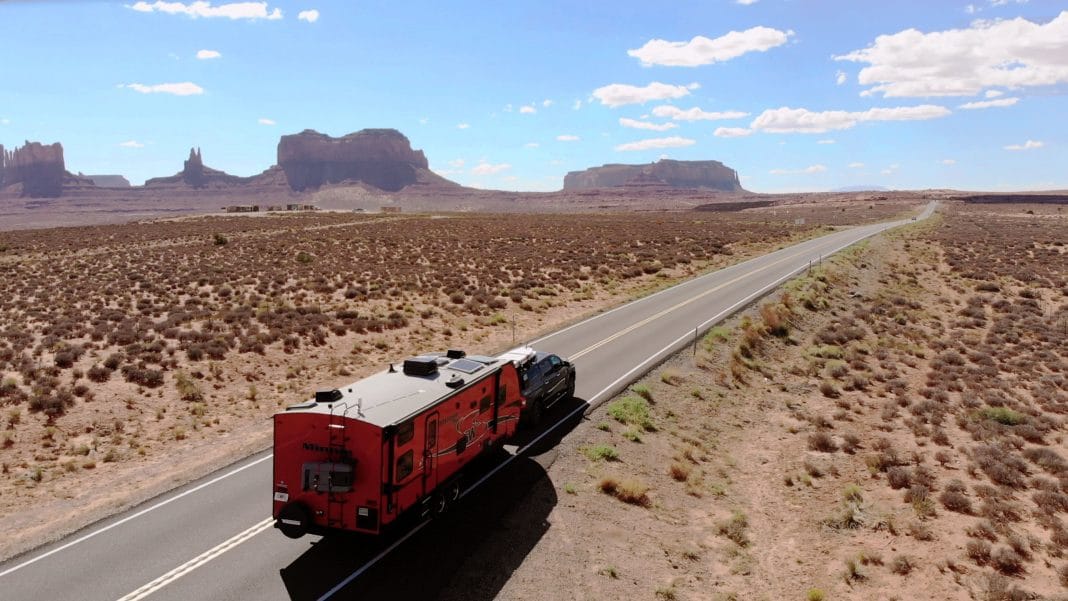Ford’s Expedition is all-new from the ground up for 2003, and the changes the company made
to its highly popular full-size SUV should endear it even more to serious drivers.
Cosmetically, the Expedition bears a strong resemblance to its smaller Explorer brother.
New sheetmetal is crisper in styling and incorporates the new front clip that helps carry
through the Ford-SUV-family appearance. New jeweled headlamps and tail-lights, modern
bumper fascias and more-smoothly integrated window glass with improved aerodynamics add up
to a fresh new image. A redesigned rig has to start with the chassis. The 2003 Expedition
features an all-new frame that’s 70 percent stiffer than before and incorporates an
independent rear suspension (IRS), which is a first for a full-size SUV. Up front there’s
the usual double-A-arm independent suspension, and coil springs over shocks at all four
corners are standard, while four-corner airbag suspension is optional. The IRS feature is a
boon to towing enthusiasts because it locks the truck’s aft end securely in place without
allowing the side-to-side movement possible with a solid axle and leaf springs. This
translates into more-secure towing and stable trailer handling. Four-wheel disc brakes with
an anti-lock braking system (ABS) are standard, and a power-assisted, speed-sensitive
rack-and-pinion steering gearbox is used on both 2WD and 4WD Expeditions. An optional
AdvanceTrac stability-enhancement system works with the truck’s ABS and engine management
to monitor directional stability and help prevent and control skids during aggressive
cornering. Powertrain options include a base 4.6-liter, 232-hp Triton V-8 and an upgraded
260-hp, 5.4-liter V-8, both of which are backed by a 4R70W four-speed automatic with
overdrive. All 4WD Expeditions use Ford’s ControlTrac four-wheel-drive system with an
electronic monitor that anticipates and prevents wheel slippage for improved off-pavement
traction. A maximum 8,900-pound tow rating is possible for the 2003 model. The IRS
facilitated the truck’s aft-end frame configuration, which made possible the new third-row
seat that folds flat into the floor for cargo hauling. In addition, the seat-folding
mechanism is powered for one-button ease of use. Another benefit of the new chassis is
lower step-in height for improved passenger access. Buyers have several choices in the
second-row seat area, including a standard 40/20/40 split bench with a forward-sliding
center section for extra-long cargo storage. The entire bench also flips and folds to
expand the aft cargo area. An optional pair of captain’s chairs provides a walk-through
option for access to the third-row seat. Up front, the driver has a view of an all-new
dashboard with stylish-but-effective instrument and control design and color-coordinated
materials throughout. Leather seating surfaces are optional on XLT and FX4 models and
standard on Eddie Bauer models, which also include heated or cooled front seats. Adjustable
gas and brake pedals make it possible for a wide variety of driver sizes to be
accommodated. The large center console has enough space to stash a laptop computer as well
as house a tissue box, and features CD and cassette storage and assorted other necessities.
Cupholders for all occupants are standard, of course. Entertainment features include a
160-watt AM/FM/CD with an optional 340-watt, seven-speaker audiophile system with a
six-disc CD changer built into the dash and a standard subwoofer. There’s also an optional
entertainment center with a 7-inch digital LCD screen that flips down from the ceiling and
ties in to a DVD player. An optional navigation system includes a 5-inch display up front
for easy visiblity. Safety is another priority for the 2003 Expedition. The front airbags
include sensors that adjust airbag-deployment levels to match the crash severity, seat-belt
use and other vehicle operation aspects. Side airbags known as a “Safety Canopy” help
protect occupants during side impacts or rollovers, and the truck also includes safety-belt
pretensioners, load-limiting retractors, buckle sensors and a driver’s-seat position
sensor. An electronic reversing aid, which warns the driver of an approaching rear
obstruction during backing, is standard on Eddie Bauer and optional on XLT Expeditions.
Ford is aiming for the Expedition to be the benchmark against which other full-size SUVs
are measured, and the new features on the 2003 model give it even more user appeal.
2OO3 Expedition
Originally Published in Trailer Life Magazine

Do not have an account? Create New Account

